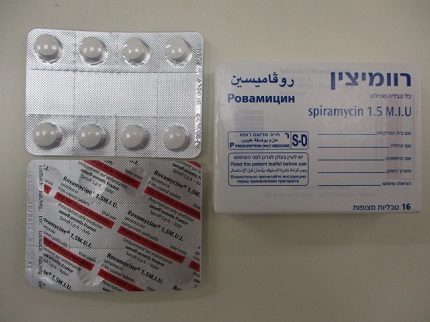Quest for the right Drug

רוומיצין ROVAMYCIN (SPIRAMYCIN)
תרופה במרשם
תרופה בסל
נרקוטיקה
ציטוטוקסיקה
צורת מתן:
פומי : PER OS
צורת מינון:
טבליות מצופות פילם : FILM COATED TABLETS
עלון לרופא
מינוניםPosology התוויות
Indications תופעות לוואי
Adverse reactions התוויות נגד
Contraindications אינטראקציות
Interactions מינון יתר
Overdose הריון/הנקה
Pregnancy & Lactation אוכלוסיות מיוחדות
Special populations תכונות פרמקולוגיות
Pharmacological properties מידע רוקחי
Pharmaceutical particulars אזהרת שימוש
Special Warning עלון לרופא
Physicians Leaflet
Pharmacological properties : תכונות פרמקולוגיות
Pharmacodynamic Properties
5.1 Pharmacodynamic properties Pharmacotherapeutic group: antibacterials for systemic use, ATC code: J01FA02 Spiramycin is an antibacterial antibiotic of the macrolide group. ANTIBACTERIAL SUSCEPTIBILITY TESTING The MIC breakpoints differentiating susceptible strains from intermediate strains, and intermediate strains from resistant strains are as follows: S <1 mg/L and R >4 mg/L The prevalence of acquired resistance in certain species may vary geographically and over time. It is therefore useful to have information on the prevalence of local resistance, especially when treating severe infections. These data are only guidelines indicating the probability of susceptibility of a bacterial strain to this antibiotic. When the variability of prevalence of resistance is known for a given bacterial species in France, it is indicated in the following table: Category Incidence of acquired resistance in France (> 10%) (range) SUSCEPTIBLE SPECIES Gram positive aerobes Bacillus cereus Corynebacterium diphtheriae Enterococci 50% – 70% Rhodococcus equi Methicillin-sensitive staphylococcus Methicillin-resistant staphylococcus* 70 – 80% Streptococcus B Unclassified Streptococcus 30 – 40% Streptococcus pneumoniae 35 – 70% Streptococcus pyogenes 16 - 31% Gram negative aerobes Bordetella pertussis Branhamella catarrhalis Campylobacter Legionella Moraxella Anaerobes Actinomyces Bacteroides 30 – 60% Eubacterium Mobilincus Peptostreptococcus 30 – 40% Porphyromonas Prevotella Propionibacterium acnes Other Borrelia burgdorferi Chlamydia Coxiella Leptospires Mycoplasma pneumoniae Treponema pallidum MODERATELY SUSCEPTIBLE SPECIES (in vitro intermediate susceptibility) Gram negative aerobes Neisseria gonorrhoeae Anaerobes Clostridium perfringens Others Ureaplasma urealyticum RESISTANT STRAINS Gram positive aerobes Corynebacterium jeikeium Nocardia asteroides Gram negative aerobes Acinetobacter Enterobacteria Haemophilus Pseudomonas Anaerobes Fusobacterium Others Mycoplasma hominis Spiramycin has in vitro and in vivo activity on Toxoplasma gondii. * The incidence of methicillin resistance is approximately 30 to 50% for all staphylococci and is mainly found in the hospital setting.
Pharmacokinetic Properties
5.2. Pharmacokinetic properties Absorption Absorption of spiramycin is rapid but incomplete. Food has no effect on absorption. Distribution After oral administration of 6 MIU of spiramycin, the peak serum concentration is 3.3 microgram/mL. The plasma half-life is close to 8 hours. Spiramycin does not pass into the CSF. It is excreted in breast milk. The medicinal product is poorly bound to plasma protein (10%). Spiramycin is very well distributed in saliva and tissue (lungs: 20 - 60 microgram/g; tonsils: 20 - 80 microgram/g; infected sinuses: 75-110 microgram/g; bone: 5-100 microgram/g). Ten days after treatment discontinuation, 5 to 7 microgram/g of active substance remains in the spleen, liver and kidneys. Macrolides penetrate and accumulate in phagocytes (neutrophils, monocytes, peritoneal and alveolar macrophages). Intraphagocyte concentrations are high in humans. These properties account for the effect of macrolides on intracellular bacteria. Biotransformation Spiramycin is metabolised in the liver, resulting in the formation of chemically unknown though active metabolites. Elimination - Urine: 10% of the ingested dose. - Biliary excretion is very high, i.e., 15 to 40 times higher than serum concentrations. - Appreciable amounts of spiramycin can be found in the faeces.

שימוש לפי פנקס קופ''ח כללית 1994
לא צוין
תאריך הכללה מקורי בסל
לא צוין
הגבלות
לא צוין
מידע נוסף
עלון מידע לצרכן
11.10.20 - עלון לצרכן אנגלית 14.03.22 - עלון לצרכן עברית 11.10.20 - עלון לצרכן ערבית 12.10.22 - עלון לצרכן אנגלית 12.10.22 - עלון לצרכן עברית 12.10.22 - עלון לצרכן ערבית 11.01.24 - עלון לצרכן עברית 26.08.15 - החמרה לעלון 25.05.20 - החמרה לעלון 14.03.22 - החמרה לעלון 08.02.24 - החמרה לעלוןלתרופה במאגר משרד הבריאות
רוומיצין